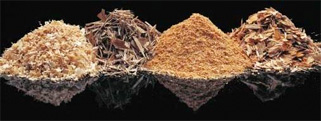
Biomass
What is it?
It is any kind of organic matter coming from trees, plants, farming and urban waste as well as animal remains, convertible into energy. The exploitation of this kind of energy can be produced directly, through combustion, or through the transformation of other substances that may be used later on as fuel.
There are different kinds of biomass according to their origin. The most interesting one from the point of view of industrial exploitation is dry waste biomass, coming from residues of farming activities, such as the almond shell or the mark, and the wet waste biomass, basically derived from energy crops.
Biomass energy is to be extracted from a series of chemical transformation processes such as pyrolysis or gasification; or biological such as fermentation processes to obtain alcohols and esters. The best known products among biological processes are the so-called biofuels.
Advantages.
- It has a neuter effect on global warming, as the CO2 sent off in its combustion had been previously absorbed by the plant matter, the origin of biomass.
- Its contents in sulphurs are under 0.1%, and therefore, do not contribute to acid rain.
- It adds up to energy diversification.
- The use of biomass can help to encourage rural economies and actually reduce soil erosion.
One of the main disadvantages is that the intensive use of energy crops may exhaust the soil’s resources.